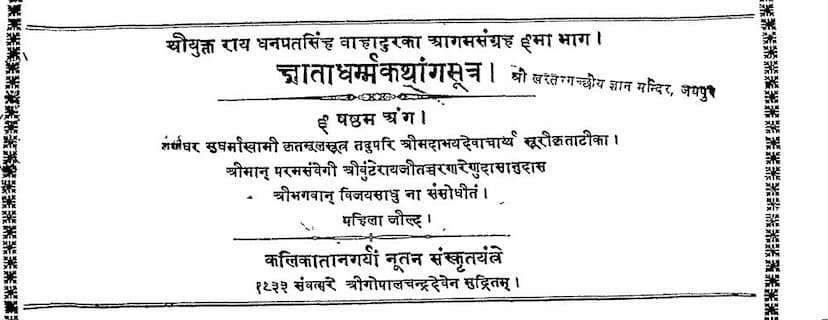Agam 06 Ang 06 Gnatadharma Sutra Shwetambar
Added to library: September 1, 2025

Summary
This Jain text, the Gnādharmasūtra, part of the Angas in the Shvetambara canon (specifically the sixth Anga, also known as the Āchārāṅgasūtra in some traditions, though the provided text seems to be a commentary on the Sūtrakṛtāṅgasūtra based on the title's mention of the sixth Anga and the content). The text, compiled and published by Rai Dhanpatsinh Bahadur, is a commentary on the Gnādharmasūtra, originally composed by Subhadra Suri and further elaborated by Āchārya Abhayadeva Suri.
The text provides a detailed and elaborate description of the city of Campā, the capital of King Shrenik (Jarasandha in the Mahābhārata, but identified as Shrenik in Jain tradition). The narrative highlights the prosperity, beauty, and organization of the city, painting a vivid picture of a well-established urban center in ancient India.
Here's a breakdown of the key themes and content covered in the provided pages:
I. Description of Campā:
- Grandeur and Prosperity: The text dedicates significant portions to describing Campā, emphasizing its grandeur. It mentions a well-planned city with wide streets, opulent mansions, beautiful gardens, and public facilities like baths and reservoirs.
- Economic Hub: The city is depicted as a thriving center of commerce, with prosperous merchants and well-stocked markets. The presence of various trades and crafts is implied.
- Cultural and Religious Life: The narrative touches upon the religious and cultural aspects of Campā, mentioning the existence of temples (chetiyas) and the prevalence of various arts and performances, including music, dance, and theatricals.
- Social Harmony and Order: The text suggests a well-regulated society where merchants, citizens, and even the ruling class seem to contribute to the city's prosperity. There's a focus on the well-being and happiness of the populace.
- King Shrenik's Rule: King Shrenik is portrayed as a benevolent ruler, with mentions of his justice and concern for his kingdom.
II. Narrative Elements and Characters:
- The Story of Meghakumara: A significant portion of the text seems dedicated to the story of Meghakumara, a prince who encounters various situations and spiritual experiences. The narrative likely follows his journey, possibly involving renunciation or spiritual pursuit, as indicated by the discussions on dharma, tapas (austerities), and the path to liberation.
- The Encounter with Jain Ascetics (Niganthas): The text highlights interactions between laypeople (like the merchant Dhanapati) and Jain ascetics. These interactions often involve seeking spiritual guidance, understanding ethical principles, and the practical aspects of observing Jain vows.
- The Role of Asceticism: The text delves into the principles of Jain asceticism, including various vows (anuvratas, mahavratas), austerities (tapas), and the disciplined lifestyle of monks and nuns. This includes descriptions of their conduct, speech, and the importance of right knowledge, faith, and conduct (the three jewels of Jainism).
- The Importance of Dharma: The core message revolves around the Jain path of dharma, emphasizing detachment from worldly desires, the pursuit of spiritual knowledge, and the ultimate goal of liberation (moksha). The text likely illustrates how following dharma leads to prosperity and spiritual well-being.
III. Philosophical and Ethical Teachings:
- Karma and Rebirth: While not explicitly detailed in these initial pages, the underlying context of Jain philosophy implies a strong belief in karma and the cycle of rebirth. The stories and teachings likely serve to illustrate the consequences of actions and the path to break free from this cycle.
- Detachment and Renunciation: The narrative implicitly promotes detachment from material possessions, worldly pleasures, and the ego, as represented by the lives and teachings of the ascetics.
- Ethical Conduct: The importance of right conduct, such as non-violence (ahimsa), truthfulness (satya), non-stealing (asteya), chastity (brahmacharya), and non-possession (aparigraha), is likely woven throughout the text, often through the examples of virtuous characters and the teachings of the ascetics.
- The Path to Moksha: The ultimate aim of Jain practice is liberation (moksha), and the text likely guides the reader on how to achieve this through spiritual discipline, ethical living, and the cultivation of virtues.
IV. Commentary Style:
- Elaborate Descriptions: The text is characterized by extremely detailed and descriptive language, particularly when describing the city of Campā, the characters, and their surroundings. This thoroughness aims to provide a comprehensive understanding of the context.
- Scholarly Approach: The presence of commentary (ṭīkā) by Abhayadeva Suri indicates a scholarly tradition of interpreting and elucidating the original scriptures. This involves explaining terms, concepts, and narrative nuances.
- Didactic Purpose: The primary purpose of the text is didactic, aiming to educate and guide individuals towards spiritual enlightenment and a virtuous life in accordance with Jain principles.
In essence, the provided pages of the Gnādharmasūtra commentary offer a rich tapestry of ancient Indian urban life, interwoven with the profound spiritual and ethical teachings of Jainism. It highlights the ideal life of detachment, discipline, and the pursuit of liberation, illustrated through detailed narratives and the wisdom of Jain ascetics.